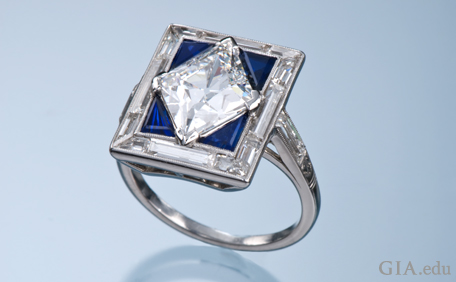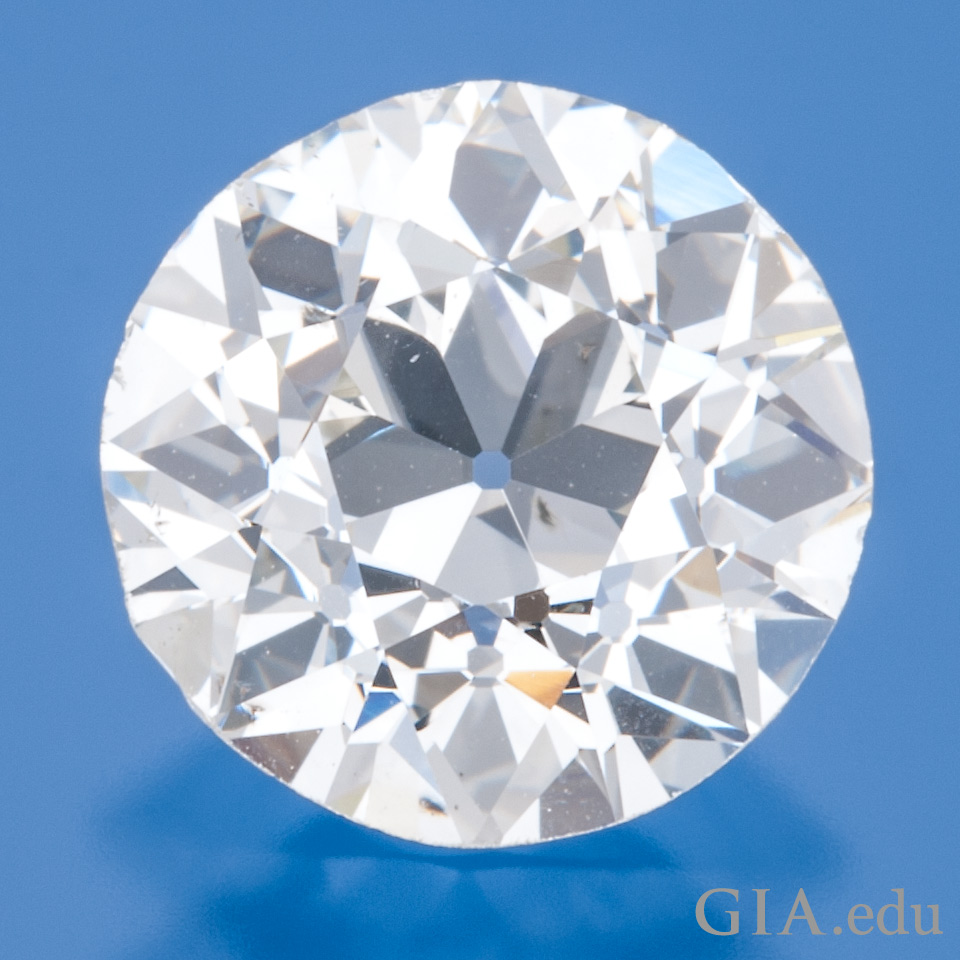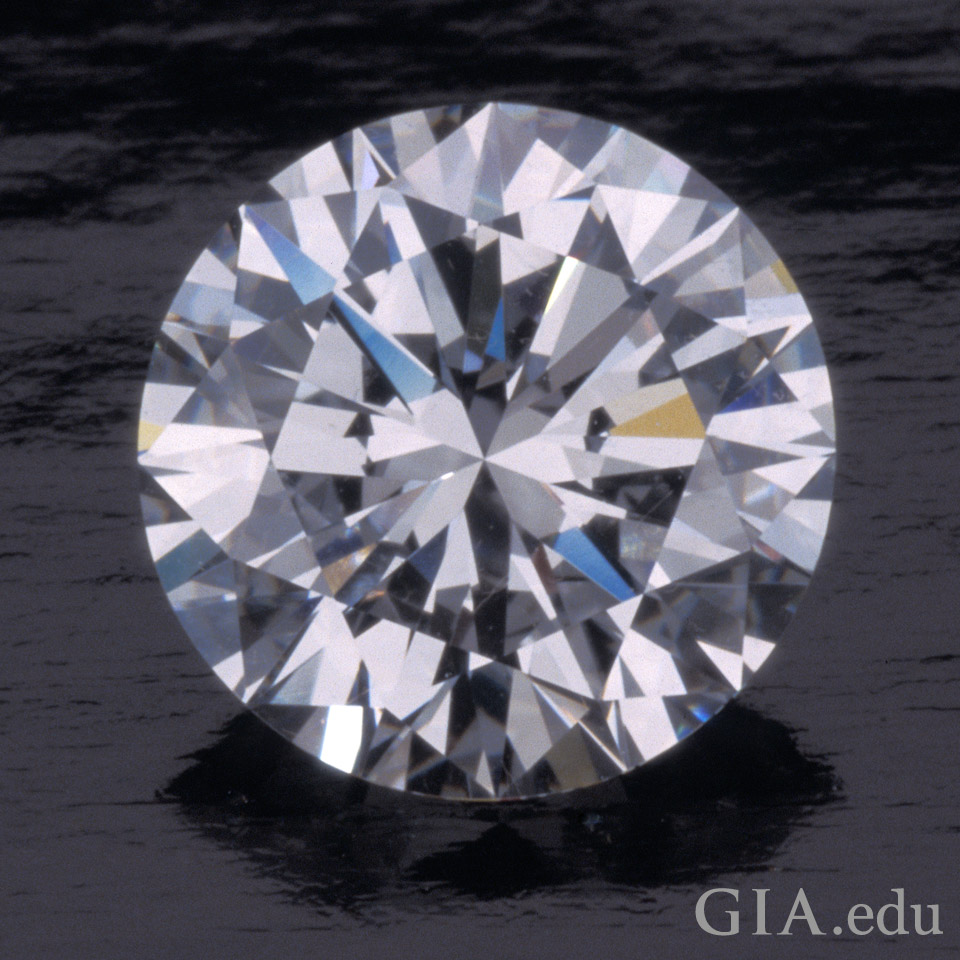Art Deco engagement rings recall an era of glamour and sophistication: elegant and timeless, this ring style is trending! Find out how to pick the right diamond shape, metal and more to create this style for your own engagement ring.
In this blog we’ll cover:
Geometric Shapes
Bold Contrasting Colors
Black and White
Diamonds and Platinum
Diamond Cuts
Art Deco was a prominent style for jewelry in the 1920s and 1930s, characterized by geometric patterns and abstract designs using diamonds and gems in contrasting colors. The fact that it was a hit was no surprise: flappers and suffragettes of the Roaring 20s had little interest in wearing tiaras, diadems, cameos and other staples of the grandes dames of Victorian England (1837-1901). Rather, they wanted rings, long necklaces, long earrings and bracelets that complemented their short skirts, shorter hair, plunging necklines – and new sense of self.
The beauty of Art Deco jewelry still captivates us: engagement rings from the Art Deco era continue to speak to the hearts and sensibilities of modern-day brides who favor simple, geometric lines. But rather than seek out a vintage ring from that period, it may be more practical to design your own engagement ring, using Art Deco jewelry design motifs as a rich source of inspiration. Here are some of the most important design elements to consider.
Art Deco Engagement Rings: Geometric Shapes
The use of geometric shapes in Art Deco designs is one of the defining characteristics of this period. Jewelry designers used shapes like triangles, squares, rectangles and circles in their creations. These stylistic choices were meant to capture the streamlined, modern spirit of the time.
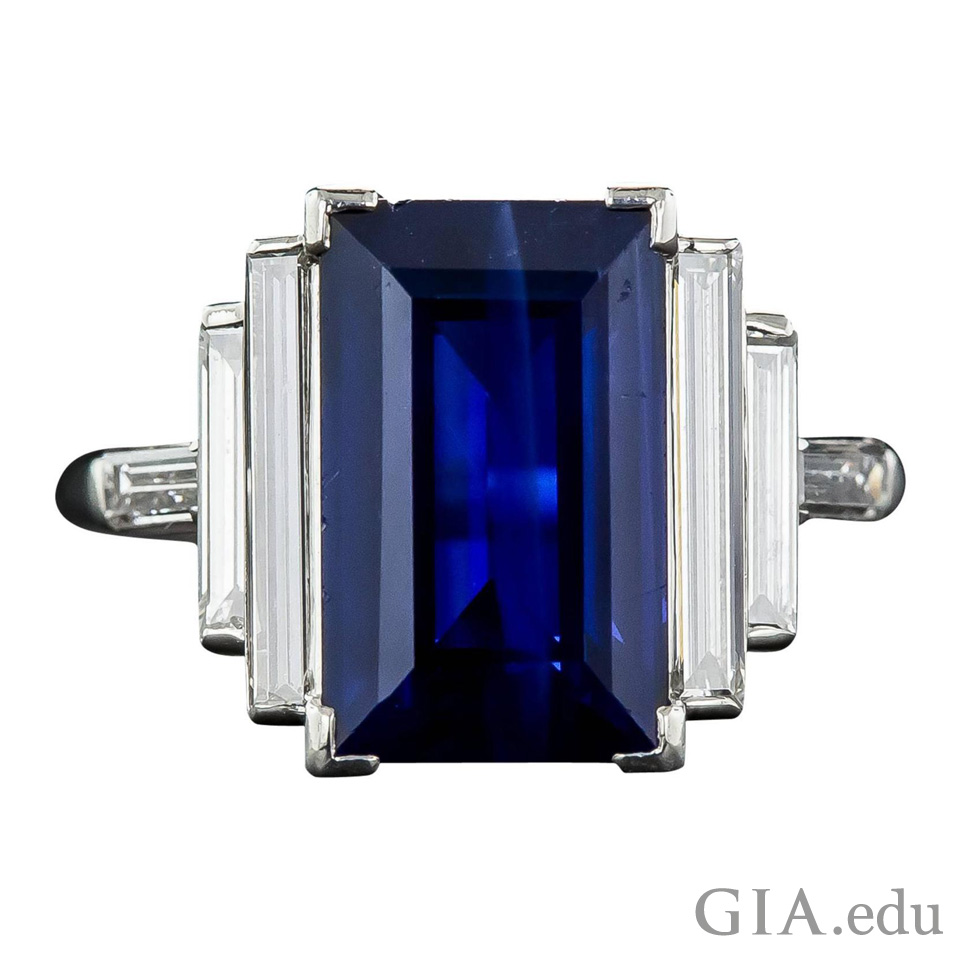
Five rectangles create the design of this Art Deco ring – and nothing else. The center stone is a 5 carat (ct) rectangular step cut sapphire, which is framed by four baguette diamonds. This restrained study of contrast, balance, and symmetry makes an impact. Courtesy: 1stdibs.com

GIA alum Sabine Getty clearly admires Art Deco. Her ring is made of simple geometric shapes using 0.16 carats of diamonds and 0.43 carats of yellow sapphire. Courtesy: 1stdibs
Art Deco jewelry designers carried the geometric motif into their choices of gemstone and diamond shapes, incorporating a number of unusual shapes in their designs. These included rectangular shapes such as emerald cuts and baguettes, triangles, shields, pear and marquise shapes.
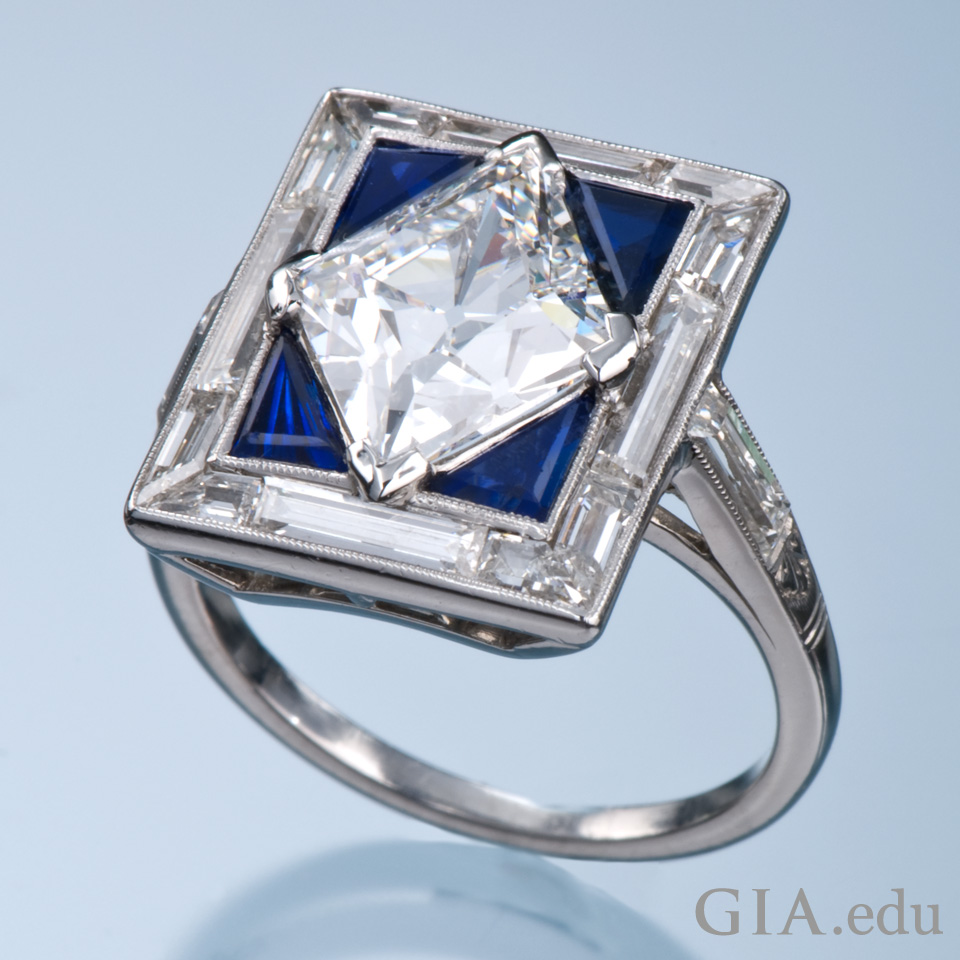
Cartier made this chic Art Deco ring around 1930. The ring has a 2.42 ct square brilliant cut diamond set at an angle; four triangular blue sapphires; and diamond baguettes on the borders. Photo: Robert Weldon/GIA. Courtesy: Frank Goodman & Son, Los Angeles, Calif.
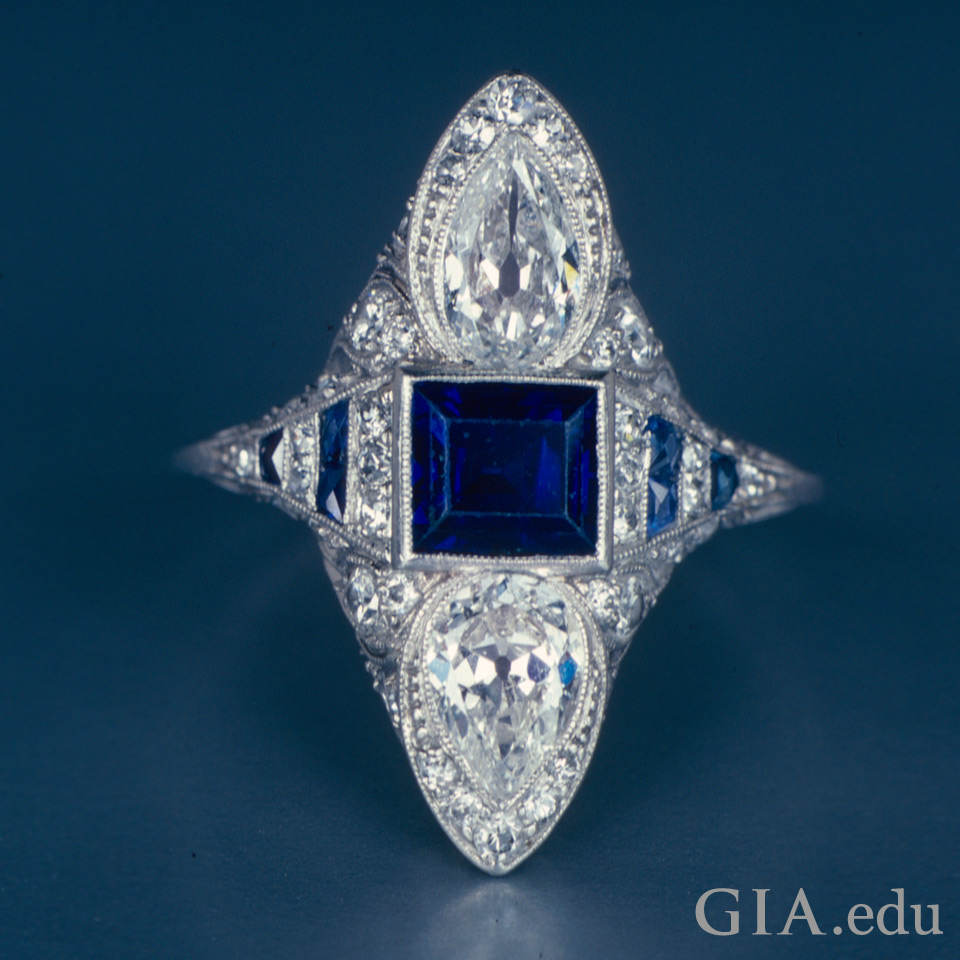
A square shaped sapphire is at the center of this Art Deco ring, sitting between two pear shaped diamonds. The overall look is one of perfect balance and symmetry. Photo: Tino Hammid/GIA
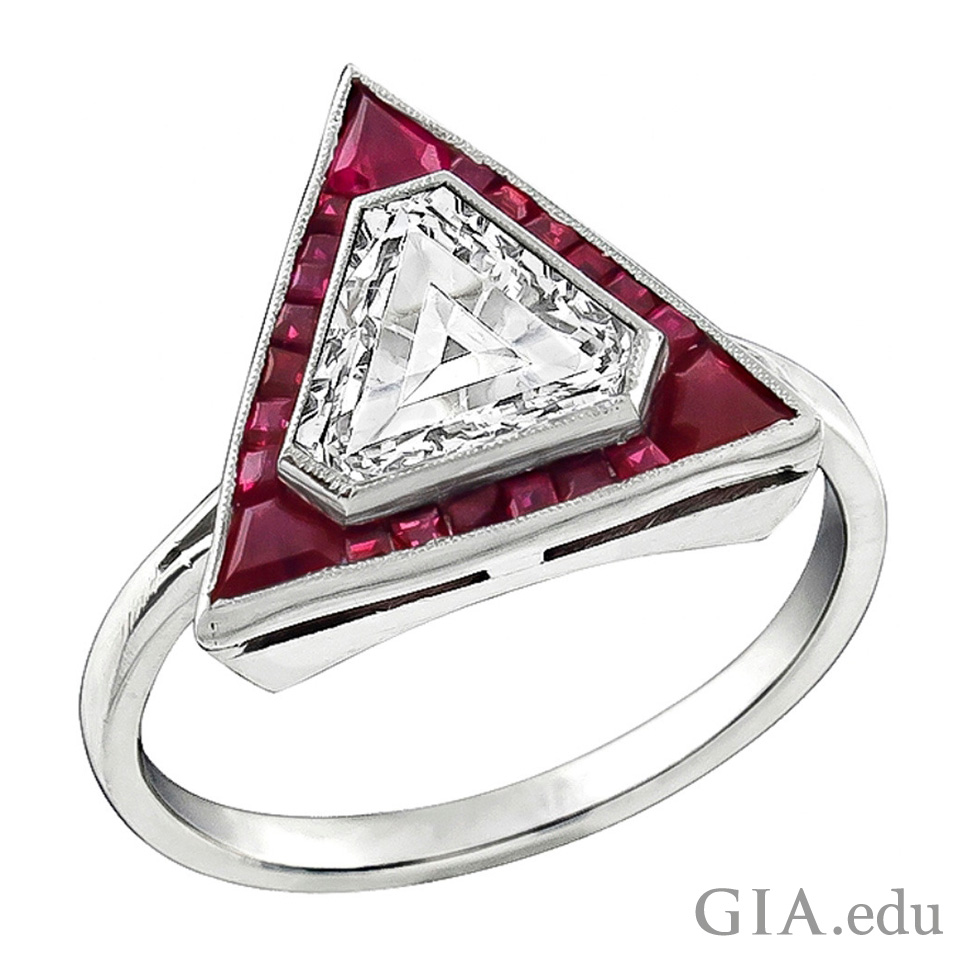
You can clearly see the influence of Art Deco in this contemporary ring, which features a 1.17 ct shield cut diamond framed by rubies totaling 0.40 carats, all set within a crisp triangle. Courtesy: 1stdibs.com
Art Deco Engagement Rings: Bold Contrasting Colors
Bold color contrasts were a signature style of the Art Deco era. Jewelry designers achieved dramatic results using diamonds with rubies, sapphires, and emeralds. They also relied on coral, jade, lapis lazuli, and turquoise to make colorful color contrasts.
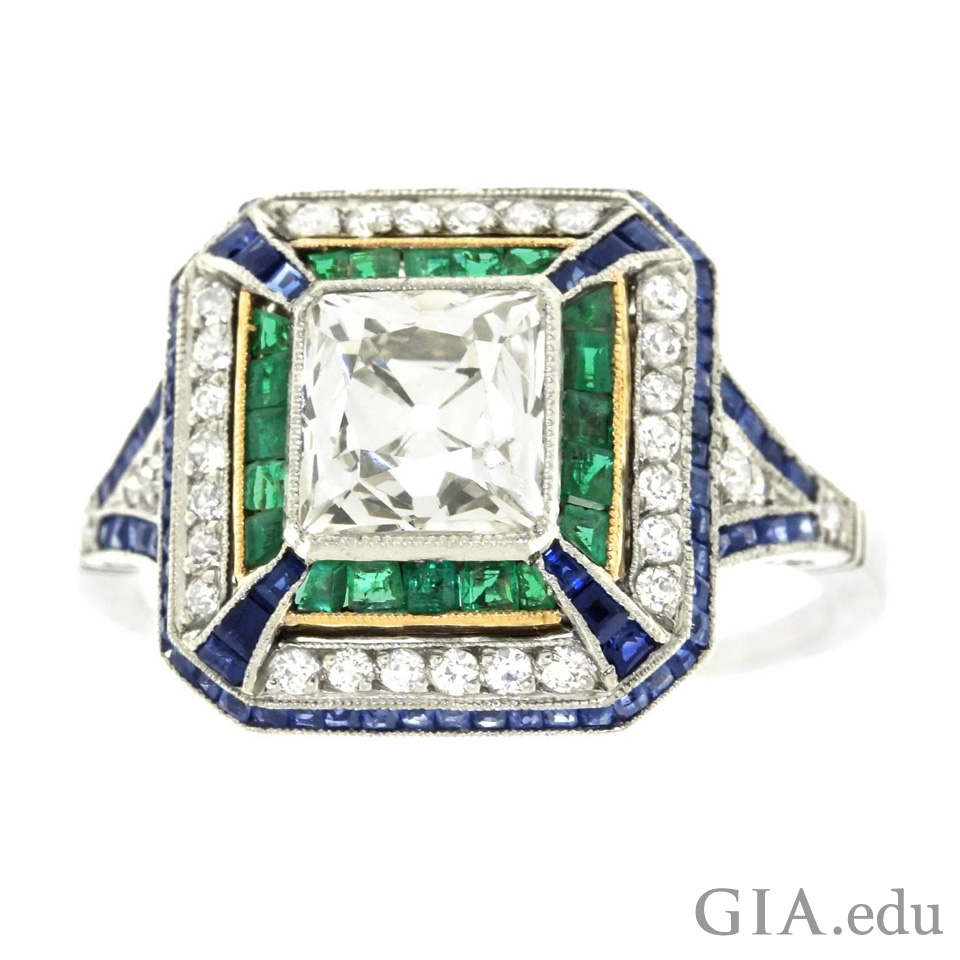
Emeralds and sapphire make for a stunning color combination. The use of a geometric pattern is another telltale sign of the Art Deco style. Courtesy: 1stdibs.com
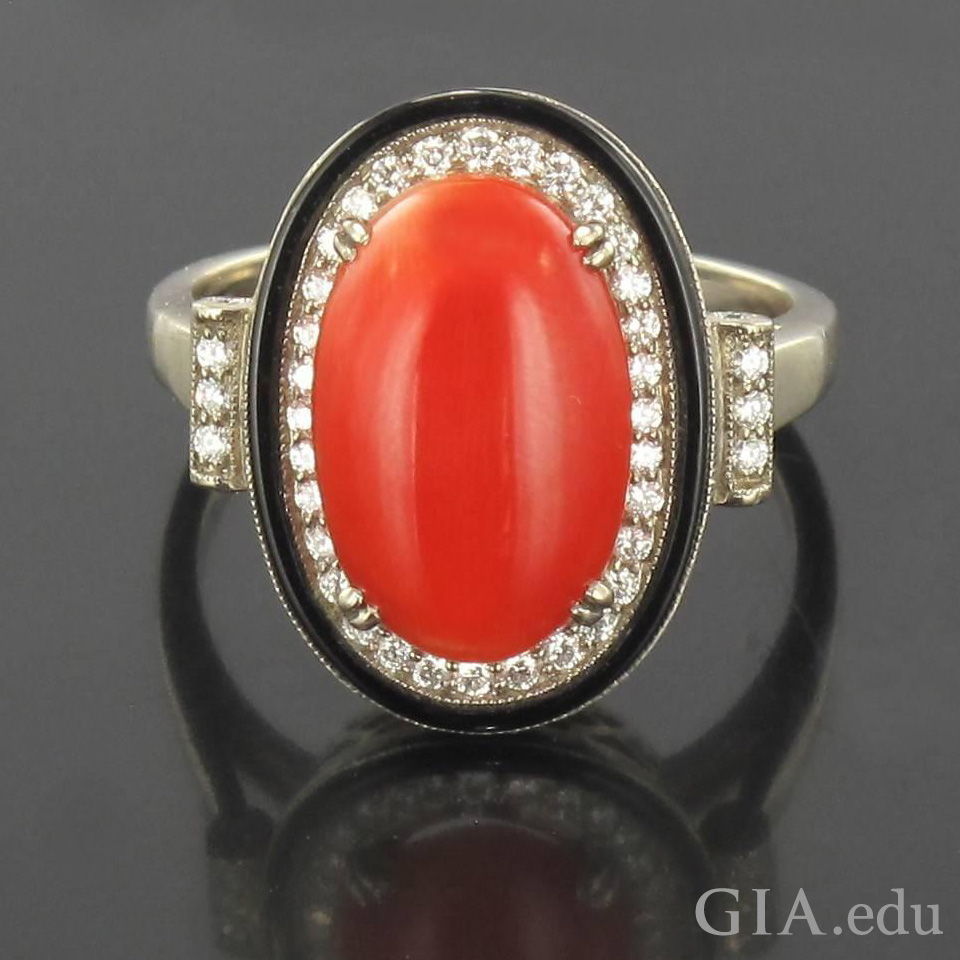
This coral cabochon, weighing approximately 4.33 ct, set in a double frame/border of diamonds and onyx create contrasting colors in this engagement ring by Baume. Courtesy: 1stdibs.com
If you’re looking to add color to your Art Deco style engagement ring, you have many gemstones to choose from. Here are just a few examples of the varieties of green gemstones, blue gemstones and pink gemstones you might consider.
Art Deco Engagement Rings: Black and White
There’s no bolder contrast than stark black and white and this combination is a telltale sign of the Art Deco style. Jewelry designers often achieved the look by combining diamonds or crystals with black onyx and/or black enameling. This color combination was a dramatic departure from the pastel colors of the Art Nouveau era.
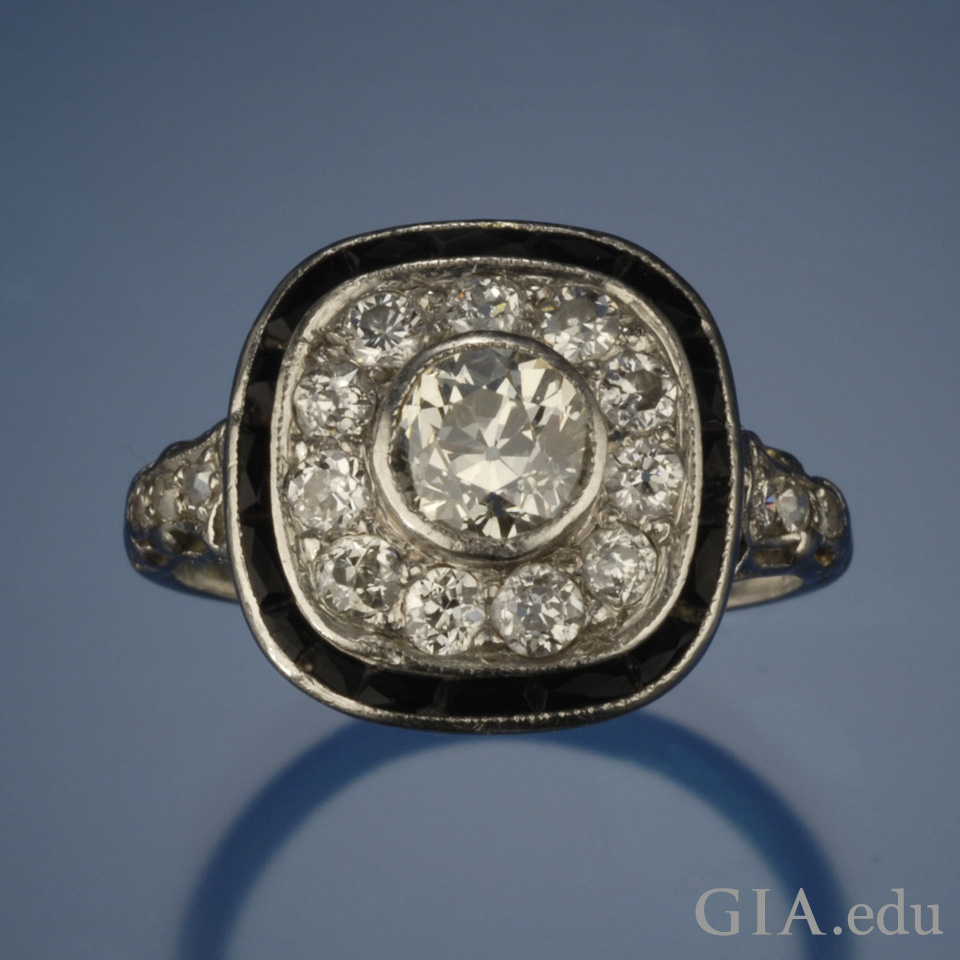
Diamond, onyx and platinum make for a stark yet chic contrast. Some brides-to-be might find this color palette to be appealing. Photo: Robert Weldon/GIA. Courtesy: Private collection

A contemporary Art Deco design, this engagement ring still bears the imprint of classic rings from the Art Deco era. Courtesy: 1stdibs.com
Art Deco Engagement Rings: Diamonds and Platinum
Diamonds were the gemstone of choice during the Art Deco period. These were often set in platinum, a metal jewelry designers favored for its strength and resistance to tarnishing. Platinum’s malleability also allowed jewelers to create the precise and intricate shapes and outlines typical of Art Deco jewelry. A popular and visually striking combination of the era: a large, colorless diamond, set in platinum often in a solitaire setting and flanked by symmetrical diamond side stones.
Small diamonds as accent stones were popular, too, and were often seen in pavé settings, a setting technique that evolved during this period.
If you’re looking for a more affordable alternative to platinum and still retain the Art Deco style, you’ll be happy to know that white gold and yellow gold were also often used, particularly during the Depression years of the 1930s.
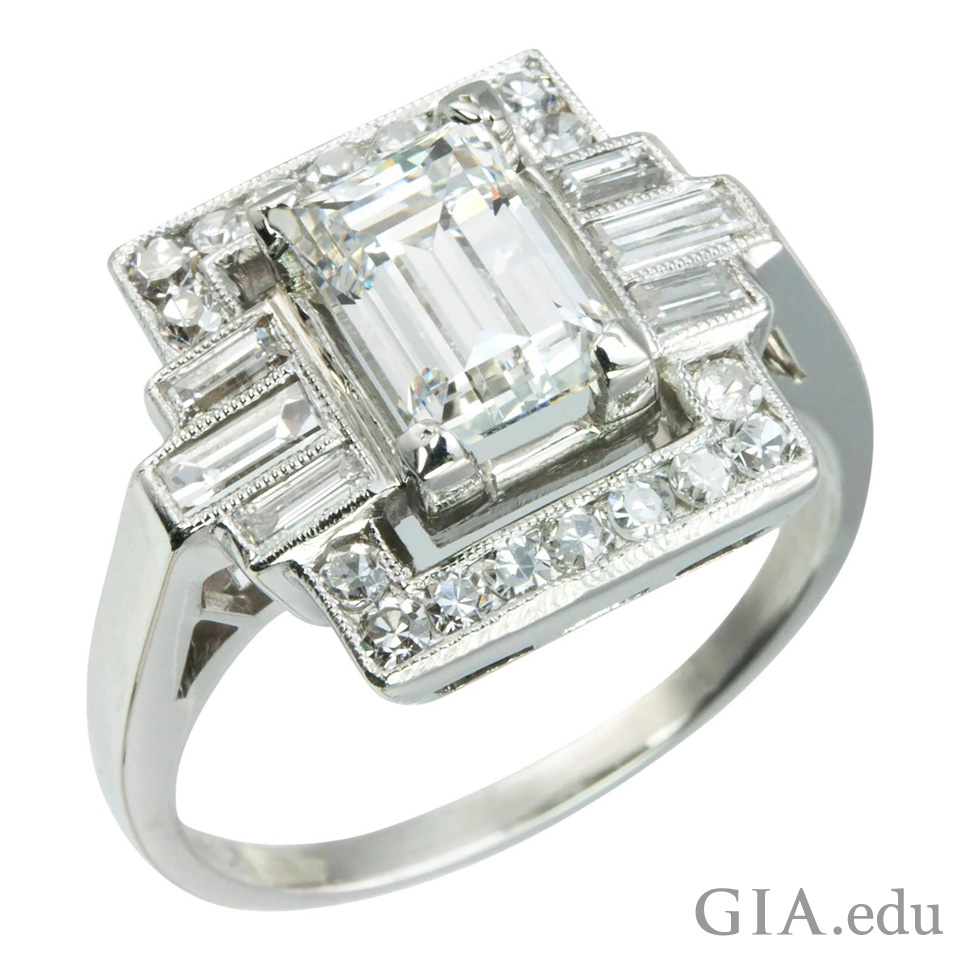
Diamond and platinum – “white on white” – was a classic combination in Art Deco engagement rings. This ring features a 1.37 ct emerald cut diamond center stone, accented by six diamond baguette side stones and 18 single cut diamonds. Courtesy: 1stdibs.com
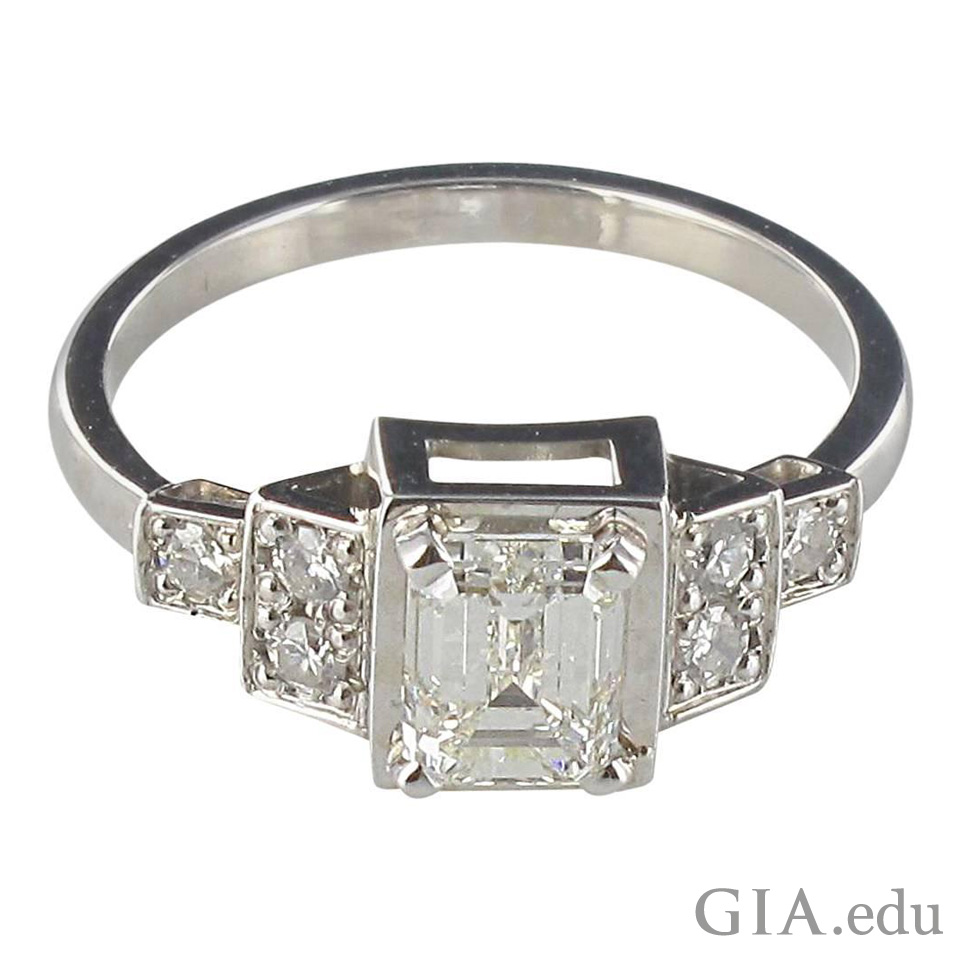
The “white-on-white” look is still extremely popular. This contemporary ring, inspired by the clean lines of the Art Deco movement, has an emerald cut diamond as the center stone, round diamonds on the sides, set in 18K white gold. Courtesy: 1stdibs.com
Art Deco Engagement Rings: Diamond Cuts
We mentioned popular Art Deco era diamond shapes above, but here we’d like to call out two diamond cuts of the period, which you can replicate in an Art Deco style engagement ring.
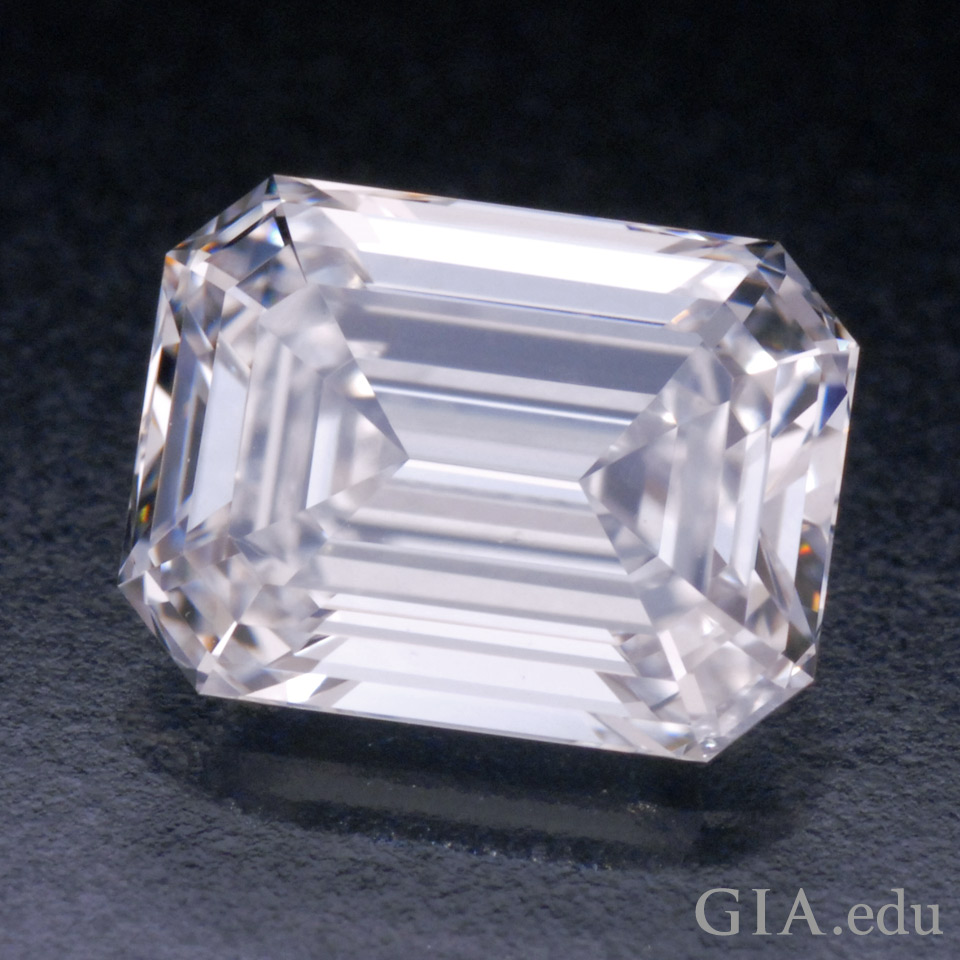
A 1.05 ct emerald cut diamond is the essence of elegance, and well-suited to the Art Deco style. Photo: Robert Weldon/GIA.
An emerald cut diamond, with its simple, clean and symmetrical outline evokes the understated elegance we often associate with the era. It was a popular choice in its day and is making a comeback – thanks in part to celebrities like George Clooney and Brad Pitt who gave their spouses emerald cut engagement rings. Clarity and color are two important quality characteristics for this style of cut. Learn what to look for in an emerald cut diamond.
Another popular diamond cut of the Art Deco era was the faceted round brilliant, a precursor to today’s modern round brilliant cut diamond. Sometimes referred to as old European cuts or “transitional cuts”, the round brilliants of this period generally have a slightly different diamond anatomy than their modern-day counterparts. These diamonds tend to have smaller table facets and larger culets, star facets and lower half facets. If you rock or tilt one of these older-style diamonds, you’ll see a different face-up pattern of light and dark than you would with a contemporary brilliant cut diamond.
Although you can still find these older round brilliant diamonds, you can get a similar look with the modern round brilliant cut diamond. Here’s what to look for in a modern round brilliant cut diamond.
Either way, it’s important is to view the diamond in person to determine which diamond is right for you.
|
Old European Cut |
Round Brilliant |
Diamond on platinum… geometric shapes… bold colors… black and white – these were some of the most important elements of Art Deco engagement rings! If the style appeals to you, you can either find an antique for the love of your life or custom design a ring of your very own. If you opt for the latter, our Guide to Custom Made Engagement Rings will show you how!
Custom Field: Array
